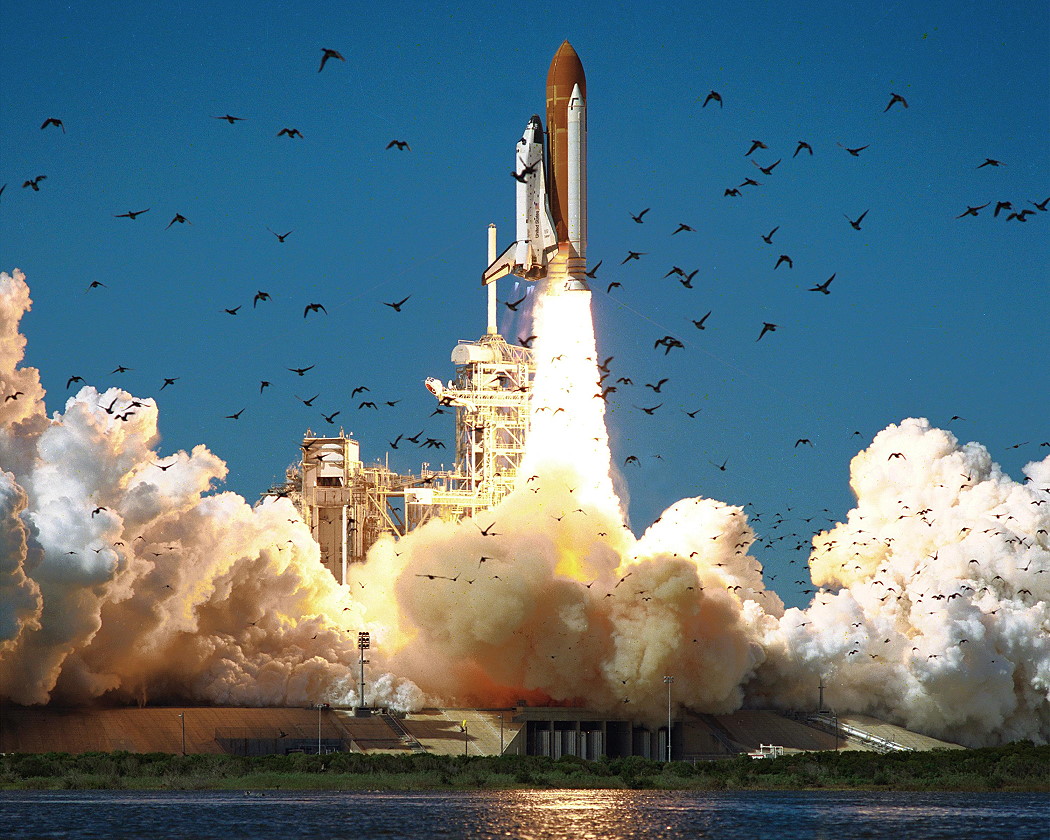
Thirty-one winters have now passed since the frightful morning of Tuesday, 28 January 1986, when Space Shuttle Challenger roared into the crystal-blue Florida sky, kicking off what should have been her 10th voyage into orbit. During almost three years of operational service for NASA, she had safely carried 46 men and women into space—one of them on no less than three occasions—and back to Earth. Those crews had delivered and repaired satellites, conducted spacewalks, and operated experiments in science and technology. The first U.S. woman astronaut had journeyed to orbit aboard Challenger, as had the first African-American spacefarer, the first Canadian, and the first Dutchman. The first untethered spacewalk had been performed from Challenger, and the first U.S. woman had spacewalked from Challenger.
Challenger, it seemed, was a charmed machine.
On Tuesday, 28 January 1986, that charm ended.
Aboard Challenger for Mission 51L were Commander Dick Scobee, Pilot Mike Smith, Mission Specialists Ellison Onizuka, Judy Resnik, and Ron McNair, and Payload Specialists Greg Jarvis and civilian schoolteacher Christa McAuliffe. As outlined in yesterday’s AmericaSpace history article, McAuliffe had been selected as part of the Teacher in Space Project (TISP), whilst Jarvis represented Hughes Aircraft Corp. and the remainder were “career” NASA astronauts. In fact, both Scobee and McNair had flown Challenger previously, whilst Onizuka and Resnik also had one shuttle mission apiece under their belts. Jarvis, McAuliffe, and Smith would be making their first spaceflights.
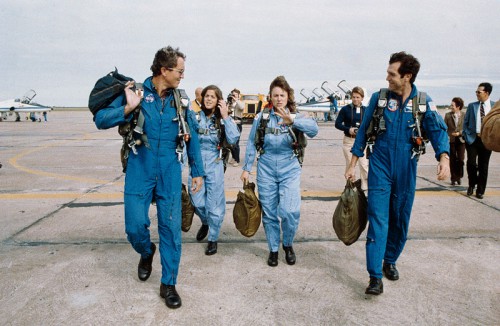
Mission 51L began at 11:38 a.m. EST. Six and a half seconds before liftoff, Challenger’s three main engines thundered to life and, as the countdown clock touched zero, the assembled spectators at the Kennedy Space Center (KSC) were greeted by the ear-splitting staccato crackle of her twin Solid Rocket Boosters (SRBs). It proved to be the failure of both the primary and secondary O-ring seals at the base of the right-hand booster, Rogers Commission investigators would later conclude from photographic, physical, and other evidence, that was directly and solely responsible for the destruction of Challenger that day.
Clear evidence of the boosters’ fallibility, made public for the first time by the Rogers report, occurred serendipitously when, 0.678 seconds after liftoff, a video camera mounted close to Pad 39B captured “a strong puff of grey smoke … spurting from the vicinity of the aft field joint of the right Solid Rocket Booster.”
The camera had identified the tell-tale result of both the primary and secondary O-rings—which were meant to stop searing gases from escaping between the joints of the booster segments—failing, disintegrating, and streaming away in the moments after ignition. More significantly, the point of failure directly faced the External Tank and its volatile liquid oxygen and hydrogen propellants, which fed the shuttle’s main engines. Any flame from the compromised booster could now play on the tank like a blowtorch, igniting its contents in a fireball and destroying Challenger, together with the entire launch complex.
Years later, Morton Thiokol structural engineer Roger Boisjoly would express astonishment that the vehicle did not explode on the pad; by an incredible sequence of events, a chunk of solid fuel temporarily plugged the O-ring hole, and the first minute of ascent proceeded normally.
Several more puffs of increasingly denser, darker smoke—further indicative that the products under combustion were indeed the grease, insulation, and rubberized O-ring material from the joint seals—were recorded by other ground-level cameras between 0.836 and 2.5 seconds after liftoff, as the boosters’ hold-down posts were severed and the shuttle commenced its climb away from Pad 39B. As each puff was left behind by Challenger’s upward trajectory, the next fresh puff could be seen close to the level of the joint. The frequency of these emissions was directly related to flexure within the structure of the SRB as the gap in its joint cycled open and closed. The last incidence of smoke above the joint was timed at T+2.733 seconds. In the milliseconds that followed, a combination of atmospheric factors and exhaust from the boosters made it difficult to determine if any more smoke was emerging from the failure point.
A little under eight seconds into the mission, as planned, the vehicle cleared the tower and began a programmed roll maneuver, moving onto the correct flight azimuth for a 28.45-degree orbit, then pitching onto her back under the control of her computers. Shortly thereafter, at T+19 seconds, to prepare herself for passage through a period of maximum aerodynamic turbulence (known as “Max Q”), Challenger’s main engines were throttled down from 104 to 94 percent, and later 65 percent, of rated thrust.
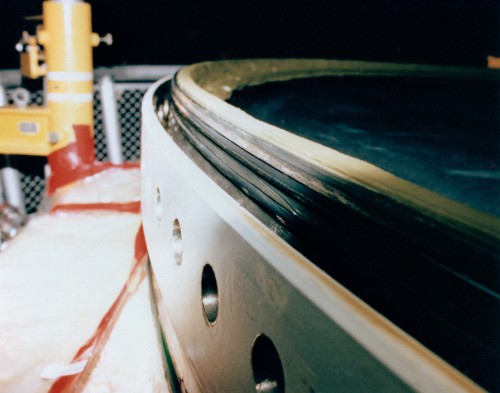
Thirty-seven seconds into the ascent, she encountered the first of several high altitude wind shears, lasting until just past a minute after launch. In its inquiry, the Rogers Commission report noted that the shuttle’s guidance, navigation, and control system immediately detected and compensated for these conditions, and—although 51L’s aerodynamic loads were higher than previous missions in both the yaw and pitch planes—the SRBs, too, responded effectively to all commands.
It is possible that the mission may still have proceeded normally, had the plug of solid fuel remained jammed into the O-ring breach. However, by an incredible stroke of cruel luck, Challenger happened to pass through the most severe wind shear ever encountered by an ascending shuttle stack. The shear dislodged the plug around a minute into the mission. After passing through maximum aerodynamic turbulence, 51 seconds into the climb, her main engines were throttled back up to full power; shortly afterward, at 58.788 seconds, a frame of video recorded the first evidence of a flickering flame from the right-hand SRB’s aft joint. The temporary plug of solid fuel had gone, and, although they were oblivious to anything amiss, the crew’s fate was now sealed.
The flame rapidly established itself, growing into a well-defined plume within half a second. Exactly a minute into the mission, downlinked telemetry pointed to an unusual chamber pressure differential between the left and right boosters—the pressure of the latter was some 11.8 psi lower than the other, indicating a leak in its aft joint. As the flame increased in size, Challenger’s aerodynamic “slipstream” deflected it backward and circumferentially by the protruding structure of the upper ring which linked the SRB to the External Tank, focusing the flame directly onto the surface of the tank.
Sixty-two seconds into the ascent, the left booster’s thrust vector control moved to compensate for the yaw motion caused by the reduced thrust from its right-side counterpart. A couple of seconds later came the first visual manifestation that the flame from the damaged booster had breached the lower segment of the External Tank: an abrupt change in the shape and color of the flame, indicating that it was now mixing with leaking liquid hydrogen. Moreover, pressurization data at around this point reinforced the fact that its liquid hydrogen tank was indeed ruptured.
In Mission Control, astronaut Dick Covey—sitting alongside fellow astronaut Fred Gregory at the Capcom’s console—relayed a standard call: “Challenger, Go at throttle up.”
Commander Dick Scobee came back a second or two later. “Roger,” he replied. “Go at throttle up.”
In the seconds that followed, an incredibly rapid sequence of events concluded with the destruction of the External Tank, the separation of both boosters, and the structural disintegration of Challenger. Seventy-two seconds after liftoff, the flame from the right SRB finally burned through the lower of two struts holding it onto the External Tank; pivoting around its upper strut, the top of the booster impacted the inter-tank and the base of the liquid oxygen tank, breaching them both. Nearly simultaneously, around T+73.1 seconds, clouds of white vapor were spotted at the top of the tank and around the area of its bottom dome: The former was clearly indicative of the ruptured liquid oxygen tank, the latter conclusive evidence of structural failure. Almost immediately, at T+73.6 seconds, came a massive—“almost explosive,” read the Rogers investigation’s report—burning of both the hydrogen leaking from the lowermost tank and the oxygen from its uppermost section.
At this point, 51L was at an altitude of nine miles (15 km) over the Atlantic Ocean, traveling at almost twice the speed of sound, and Challenger was lost from view in the resultant explosive burn. Her Reaction Control System (RCS) ruptured during this period, setting off the hypergolic burning of its propellants, evidenced by a reddish-brown hue around the edge of the fireball. Meanwhile, the two boosters, now released of their loads, rapidly climbed away from the catastrophe, but were remotely destroyed by the Range Safety Officer at 11:39:50 a.m. EST, some 110 seconds after launch. “Obviously a major malfunction,” was all Steve Nesbitt, the stunned launch commentator, could remark.
The loss of Challenger, played out as it was in the most devastatingly public fashion, would bring the shuttle program and NASA to its knees for far longer than the 32 months needed to return the reusable vehicles to flight. As described in a previous AmericaSpace history article, investigators would uncover a range of technical, managerial, and other human factors behind the tragedy, and in September 1988 a safer—though still intrinsically unsafe—shuttle would return to flight.
And with each and every launch that followed, right up to the very end of the shuttle’s 30-year history, the launch phase remained arguably the most critical. For each mission, the 73-second psychological barrier was a powerful hurdle for each crew to overcome. Even as Atlantis rocketed aloft for the shuttle program’s finale on 8 July 2011, many hearts missed a beat as STS-135 Commander Chris Ferguson called “Roger, Go at throttle up” for what would be the last time.
This is part of a series of history articles, which will appear each weekend, barring any major news stories. Next week’s article will remember the loss of Columbia during re-entry on 1 February 2003.
Be sure to “Like” AmericaSpace on Facebook and follow us on Twitter: @AmericaSpace




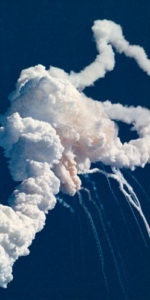
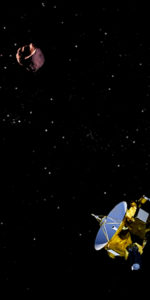
Thirty–One Years Later and the Story still Pulls on my Heart Strings…Hopefully they did Not Suffer too much after the Break-Up, but we know some Lived till they Hit the Ocean Below…R.I.P.
David P.